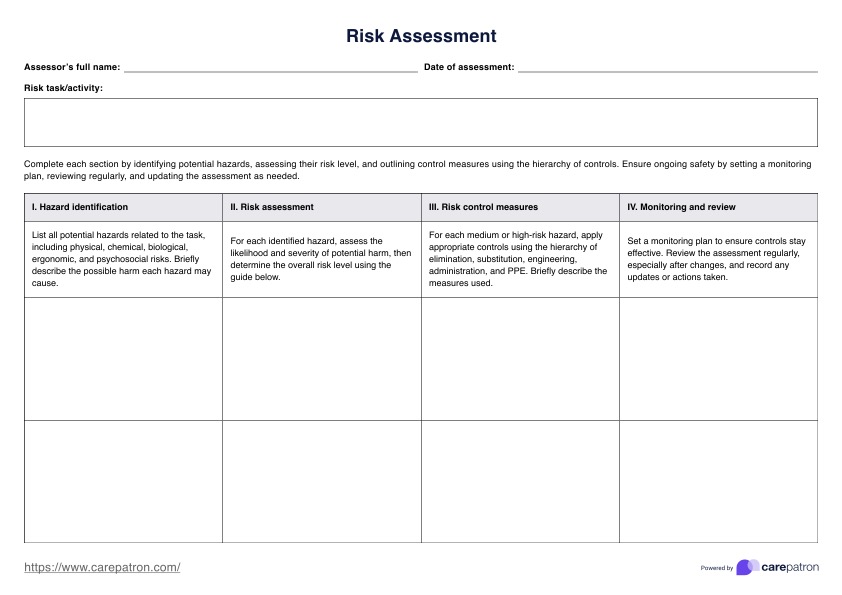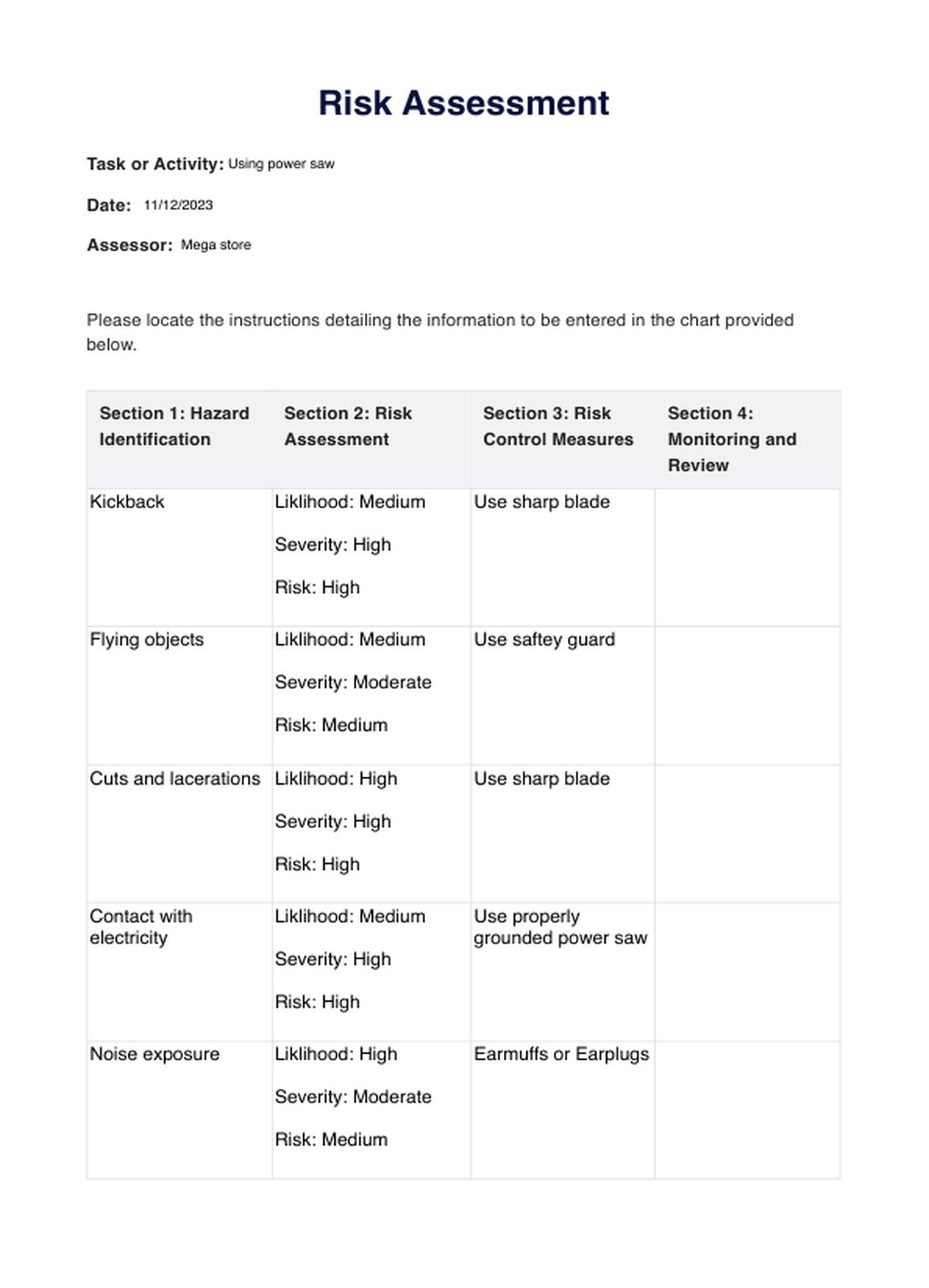Risk Assessment Template
Risk Assessment Templates identify potential harm, assess existing control measures, determine additional actions, and assign ways to action them.

By Liliana Braun on Jul 15, 2024.


Table of content
What is a Risk Assessment Template?
A Risk Assessment Template serves as a systematic and structured tool essential for recognizing, analyzing, and evaluating potential hazards and risks tied to a particular task, activity, or process. Its primary purpose is to empower organizations and individuals to proactively manage and control risks, thereby minimizing potential harm or loss.
Comprising key components, a standard Risk Assessment Template encompasses:
- Hazard Identification: A comprehensive listing of potential hazards that could pose harm or damage.
- Risk Assessment: An evaluation of the likelihood and severity of potential harm or damage associated with each identified hazard.
- Risk Control Measures: The identification and implementation of suitable control measures designed to mitigate or eliminate risks linked to each hazard.
- Monitoring and Review: The establishment of a systematic process for monitoring the effectiveness of implemented risk control measures and conducting periodic reviews of the risk assessment.
It is crucial to note that the complexity and format of the Risk Assessment Template may vary based on the specific industry and context. However, they universally adhere to the overarching principles of identifying, assessing, controlling, and systematically monitoring risks. These templates play a pivotal role in fostering a proactive approach to risk management across diverse sectors.
PDF Template
Example PDF
Risk Assessment Template

Risk Assessment Template Example

How does it work?
A Printable Risk Assessment Template is a structured tool used to identify, analyze, and evaluate potential hazards and risks associated with a specific task, activity, or process. It helps organizations and individuals proactively manage and control risks to minimize harm or loss.
Steps involved in filling out a risk assessment template:
- Identify the task or activity to be assessed: Clearly define the task or activity for which you are conducting the risk assessment.
- Identify potential hazards: Brainstorm and list all potential hazards associated with the task or activity. Consider physical, chemical, biological, ergonomic, and psychosocial hazards.
- Assess the likelihood and severity of harm: For each identified hazard, determine the likelihood (low, medium, or high) of the hazard causing harm and the severity (minor, moderate, or major) of the potential harm.
- Evaluate risks: Multiply the likelihood and severity ratings for each hazard to assess the overall risk level (low, medium, or high).
- Identify and implement risk control measures: For each hazard with a medium or high-risk level, identify and implement appropriate control measures to reduce or eliminate the risks. Consider elimination, substitution, engineering controls, administrative controls, and personal protective equipment (PPE).
- Record findings and recommendations: Document the identified hazards, assessed risks, and implemented control measures in the risk assessment template.
- Monitor and review: Establish a system for monitoring the effectiveness of risk control measures and reviewing the risk assessment regularly. Update the risk assessment as needed when changes occur to the task, activity, or work environment.
When would you use this Template?
- New or modified tasks or activities: When introducing a new task, process, or activity, it is crucial to conduct a risk assessment to identify and control potential hazards before they can cause harm.
- Changing work conditions: When there are significant changes to the work environment, such as new equipment, materials, or layout, a risk assessment can help identify and address potential hazards arising from these changes.
- Recurring tasks or activities: Even for established tasks or activities, regular risk assessments are essential to ensure that existing control measures remain effective and to identify new hazards that may have emerged.
- Pre-incident planning: Risk assessments play a vital role in pre-incident planning, helping organizations prepare for and respond to potential emergencies or incidents.
- Compliance with regulations: Many industries and regulatory bodies require organizations to conduct risk assessments as part of their safety management systems.
- Improving safety culture: Regularly conducting risk assessments fosters a proactive safety culture within an organization, encouraging employees to identify and report hazards.
- Training and education: Risk assessments serve as valuable tools for training and educating employees about workplace hazards and risk management principles.
- Incident investigation: Risk assessments can be used during incident investigations to analyze the root causes of incidents and identify preventive measures.
- Decision-making: Risk assessment findings inform decision-making regarding resource allocation, task prioritization, and safety investments.
- Continuous improvement: Risk assessments contribute to a continuous improvement process in safety management, identifying areas for improvement and enhancing overall safety performance.
What do the results mean?
When using a Free Risk Assessment Template common results include the:
- Identified hazards: A list of potential hazards associated with the task or activity being assessed. These are potential sources of harm or damage that could occur during the task or activity. Recognizing these hazards is the first step in preventing harm.
- Assessed risks: Ratings of the likelihood and severity of harm for each identified hazard. The likelihood and severity ratings indicate the potential impact of each hazard. High-risk hazards require immediate attention and priority control measures.
- Risk levels: Overall risk levels (low, medium, or high) are determined by multiplying the likelihood and severity ratings. The overall risk levels provide a quick overview of the relative risks associated with the task or activity. High-risk tasks or activities may require further evaluation or additional control measures.
- Recommended control measures: Specific actions or measures to reduce or eliminate the risks associated with medium or high-risk hazards. These are specific actions or measures that can be implemented to reduce or eliminate the risks associated with medium or high-risk hazards. Control measures can include engineering controls, administrative controls, and personal protective equipment (PPE).
- Residual risks: Risks that remain after control measures have been implemented. These are risks that remain even after control measures have been implemented. Residual risks should be monitored and managed through ongoing risk assessment and review.
Research & Evidence
Research consistently emphasizes the importance of risk assessment templates in various domains, particularly in evaluating hazards and adverse effects associated with chemical, biological, or physical exposures. These templates serve as instrumental tools in setting regulations and guidelines to prevent or minimize long-term health effects caused by exposure to low levels of toxicants. From assessing pharmaceutical safety to safeguarding workers in hazardous environments, risk assessment templates play a crucial role. The research underscores the significance of these templates in navigating the complexities of extrapolating dose and response data, minimizing uncertainty in risk estimates. The ongoing evolution of risk assessment practices and the integration of mechanistic information highlights the need for this defensible tool, emphasizing the collaborative efforts of pathologists and risk assessors to enhance its efficacy in evaluating health concerns related to chronic low-level exposures to toxicants (Brecher, 1997).
In occupational safety and health (OSH), the rigorous assessment of risks from identified hazards is crucial. This process involves anticipating events and exposures that could potentially cause harm while evaluating the likelihood or probability of their occurrence. A pivotal tool in this context is the risk assessment matrix, meticulously organized in rows and columns to categorize the foreseeable severity of harm and the likelihood of occurrence. The matrix cells indicate the level of risk, each category complemented by descriptive text and specific header terms for clarity. The significance of employing risk assessment templates, such as matrices, becomes evident in their systematic approach to identifying, evaluating, and managing risks, providing a structured framework for organizations and individuals to ensure comprehensive safety measures and minimize potential harm. Insights from usability concerns and a survey of individuals with OSH-related experience contribute to refining recommended sets of terms, enhancing the practical application of risk assessment matrices, and reinforcing their importance in effective risk management strategies (Jensen et al., 2022).






